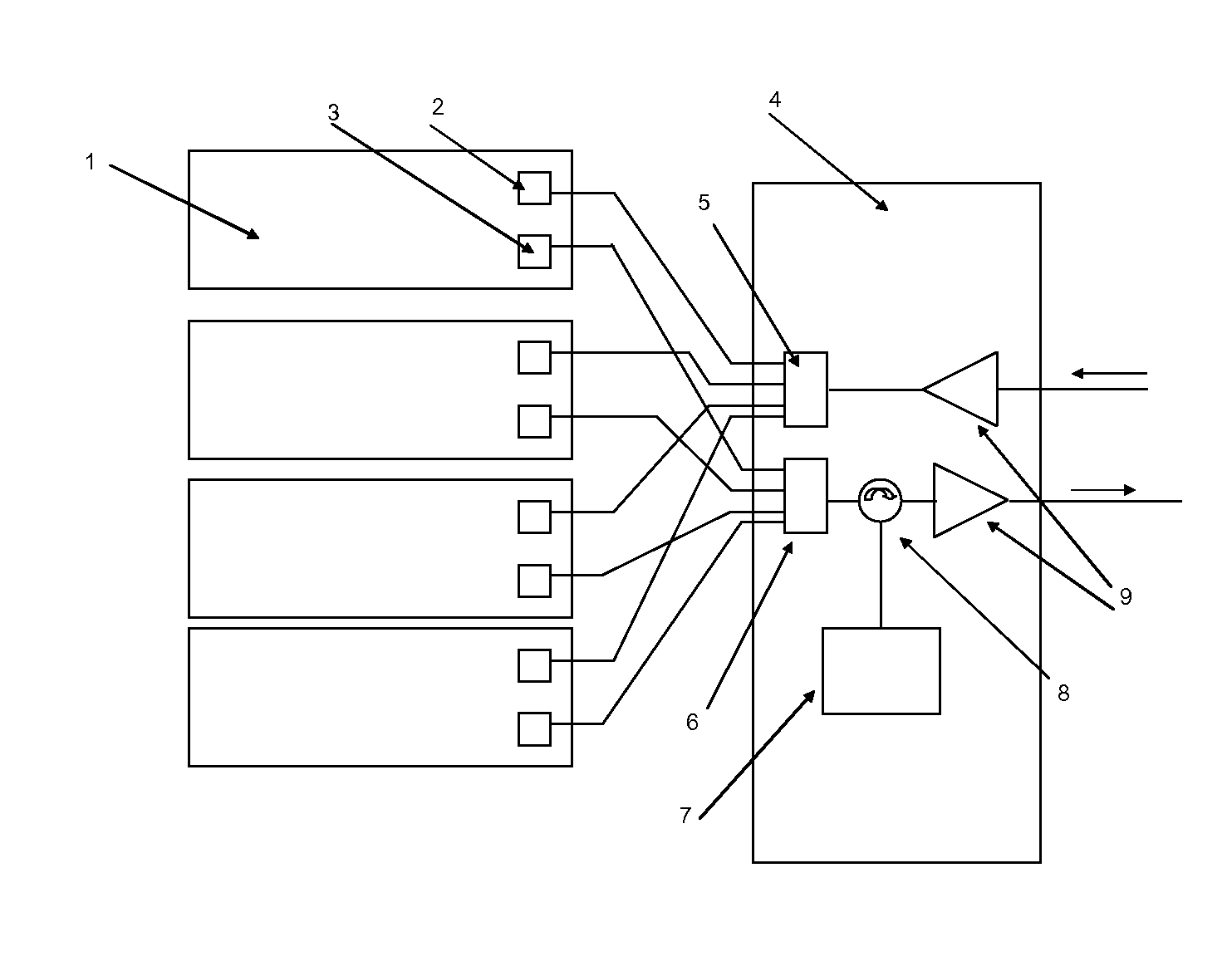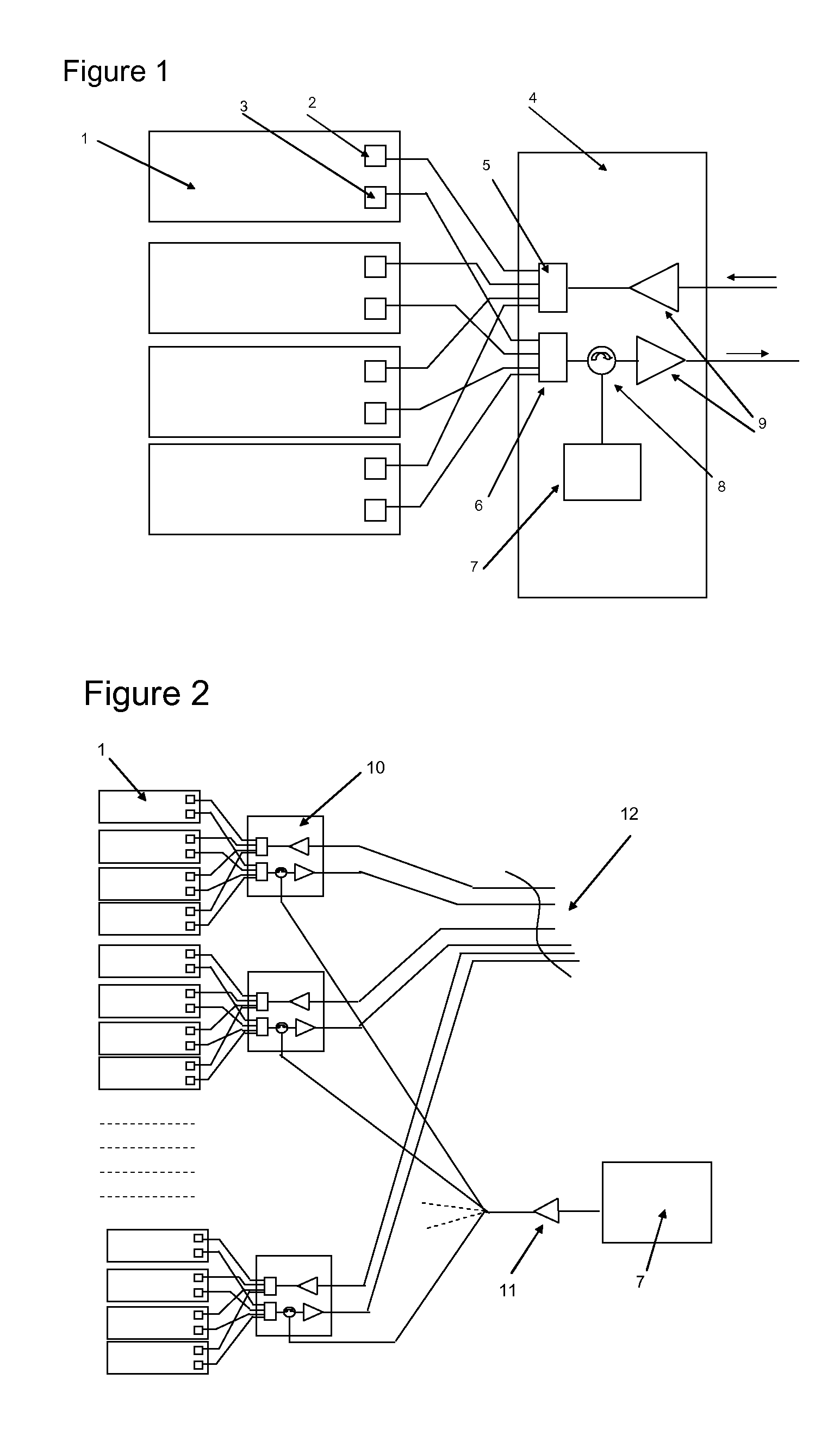Wavelength Division Multiplexing Transmission Equipment
- Summary
- Abstract
- Description
- Claims
- Application Information
AI Technical Summary
Benefits of technology
Problems solved by technology
Method used
Image
Examples
first embodiment
[0066]A first embodiment is illustrated in FIG. 1. Light from a centralised multi-wavelength source 7 producing M (typically 32) wavelengths is combined using a wavelength multiplexer to provide a single fibre output. The multi-wavelength source 7 is typically a hybrid integrated laser module containing M single wavelength lasers combined together using a planar array waveguide multiplexer. A suitable configuration for a multi-wavelength a source 7 with attractive features for this application is described in patent publication EP2082464 (A1) “Multi-wavelength Transmitter”. The combined output from the multi-wavelength source 7 is connected via a circulator 8 to an AWG 6 which acts as both a wavelength multiplexer and de-multiplexer of light coming from and to optical modulators 3. Connections from the opposite side of the AWG 6 are connected to the optical modulators 3 located on individual client equipment cards 1. The modulators 3 would typically be reflective electro-absorption ...
second embodiment
[0068]the present invention is shown in FIG. 2. In this arrangement a multi-wavelength source 7 is shared between several of the transmission systems which were described in the previous embodiment. Each of the transmission systems in this embodiment comprises a line card10 and a plurality of client cards 1. The multiple wavelength source 7 is located externally of the line cards 10. To overcome the losses resulting from sharing the multi-wavelength source 7 with multiple line cards 10, an optical amplifier 11 is included in this scheme and is connected between the source 7 and the point where the optical connection from the source 7 splits to connect to the different line cards 10. Typically this amplifier 11 would be an erbium doped fibre amplifier but other designs could also be used, including either a semiconductor optical amplifier or Raman amplifier.
third embodiment
[0069]A third embodiment is shown in FIG. 3. In this arrangement multiple wavelengths are fed to each client equipment card 1. On each client equipment card a wavelength de-multiplexer 25 (third wavelength routing element), typically an AWG device, is used to separate individual wavelengths from a plurality of wavelengths generated by a multi-wavelength source 7. An array 24 consisting of a plurality of reflective modulators on the client card 13 is used to impose data generated by the client equipment onto a set of wavelengths. The output from the array 24 of reflective modulators is then recombined using the same AWG device 25. In the example shown in FIG. 3, each client card 13 produces 10 channels each channel spaced by an optical frequency of 200 GHz. The channels on each client card 13 are multiplexed using an AWG with a flat top profile. The outputs from several client cards are then further multiplexed using an inter-leaver 18 (first wavelength routing element) on a line sid...
PUM
 Login to View More
Login to View More Abstract
Description
Claims
Application Information
 Login to View More
Login to View More - R&D
- Intellectual Property
- Life Sciences
- Materials
- Tech Scout
- Unparalleled Data Quality
- Higher Quality Content
- 60% Fewer Hallucinations
Browse by: Latest US Patents, China's latest patents, Technical Efficacy Thesaurus, Application Domain, Technology Topic, Popular Technical Reports.
© 2025 PatSnap. All rights reserved.Legal|Privacy policy|Modern Slavery Act Transparency Statement|Sitemap|About US| Contact US: help@patsnap.com



